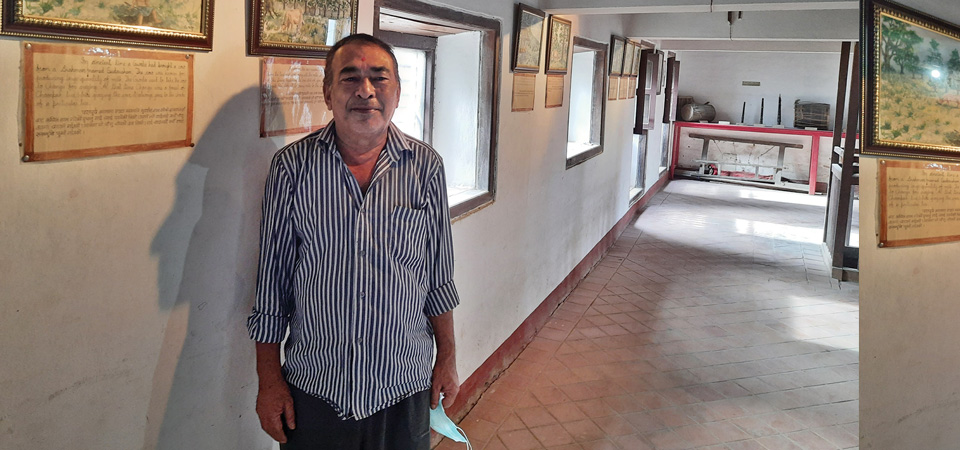Vaishnava preserving artefacts in his private museum

By Nayak Paudel
Kathmandu, Aug. 5: It has been 21 years since Vaishnava Raj Shrestha, 69, has been operating a private museum beneath the Changu Narayan Temple. It was when the then government decided to celebrate 1998 as Visit Nepal Year that Shrestha became motivated to open up a museum where he could preserve as much history and culture as he could.
"There were many objects with great cultural and historical importance during my early days. But slowly our culture and history started disappearing and it made me unhappy. When the Visit Nepal Year was announced, I too chose to make people and new generation aware of our history and culture by preserving it," said Shrestha, recalling his struggle to bring the museum into operation.
It took him two more years to collect enough objects to showcase at his museum. Shrestha finally opened the museum at his own house on May 23, 2000. He has many objects with him passed down through generations. Some of them were bought while others received as gift from well-wishers.
The museum was named "Changu Museum". Situated in his old house, the number of objects started increasing year after year and it led him to shift to a new place.
"The old house had low ceilings making it difficult for visitors. The valuable objects were also at risk, due to which I decided to shift it to a new house," Shrestha told The Rising Nepal.
It was only couple of year before the 2015 earthquake that Shrestha had shifted to a new house. The old one got destroyed during the earthquake. The new four-storey house was designed to accommodate the museum along with Shrestha's family of nine.
The museum starts from the ground floor. While entering, the visitors pass through a series of paintings with descriptions on how the Changu Narayan Temple was discovered and established centuries ago.
Shrestha walks alongside the visitors and guides them through the objects describing their historical and cultural importance.
"I feel glad to pass the knowledge of our history and culture to others. When visitors hear you describing a proud past filled with culture and tradition and leave the museum with a smile and satisfaction of learning something valuable, it gives me all the happiness I want," he said.
After the paintings, visitors pass through a set of different musical instruments used in a variety of purposes such as ceremony, festival and singing hymns. There are also ancient weighing systems, calendars and books of rituals, and a room full of currencies and coins of the past.
Shrestha has a Mananka, the oldest coin of Nepal dating back to the 5th century, as well as coins used during the Malla and Shah periods.
From a leaf with the writings of a crow to the stones which fell during lightning strikes, the museum also has a room constructed in a typical Newari style at the top floor.
"The kitchen and praying room should always be on the top floor as per the Newari tradition. The kitchen should be on the east-south side while the praying room on the east-north side," said Shrestha.
The kitchen also consists of ancient utensils.
Shrestha now hopes to increase the number of objects in the museum and plans to add new rooms soon. However, since he is handling this all alone, it is a herculean task for him.
The museum hasn’t received any support from the local or other government authorities yet. But he is happy with what the visitors leave behind in the visitors' book and the smile of satisfaction on their faces.
"The museum had many artefacts which I had only read in books. A man's determination to preserve and protect the artefacts is an inspiration," said Abhishekh Subba, a visitor who had arrived there from Kathmandu.
Shrestha stressed that he would continue improving the museum until he can, and is assured that his family would tread in his footsteps afterwards.
"I haven’t received any support from the government, but have received everything I need from my family and community. They help me run the museum effectively, and I am sure they too want to protect the culturally and historically important objects for the new generations," Shrestha said.
He also urged every Nepali to preserve the historically and culturally significant objects as they are the real treasures passed down through generations.
Recent News

Do not make expressions casting dout on election: EC
14 Apr, 2022
CM Bhatta says may New Year 2079 BS inspire positive thinking
14 Apr, 2022
Three new cases, 44 recoveries in 24 hours
14 Apr, 2022
689 climbers of 84 teams so far acquire permits for climbing various peaks this spring season
14 Apr, 2022
How the rising cost of living crisis is impacting Nepal
14 Apr, 2022
US military confirms an interstellar meteor collided with Earth
14 Apr, 2022
Valneva Covid vaccine approved for use in UK
14 Apr, 2022
Chair Prachanda highlights need of unity among Maoist, Communist forces
14 Apr, 2022
Ranbir Kapoor and Alia Bhatt: Bollywood toasts star couple on wedding
14 Apr, 2022
President Bhandari confers decorations (Photo Feature)
14 Apr, 2022










